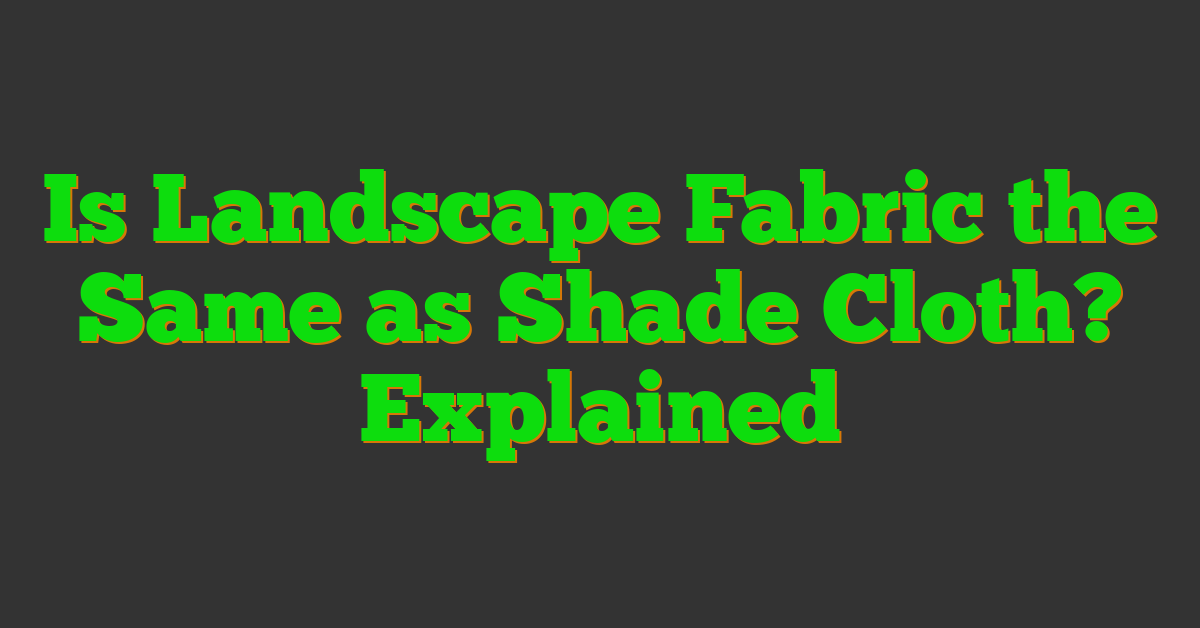If you’re new to gardening, you might be wondering what the difference is between landscape fabric and shade cloth. While both products are used in gardening, they serve different purposes. Landscape fabric is typically used to control weeds and stabilize soil, while shade cloth is used to provide shade and protect plants from the sun. In this article, we’ll explore the differences between landscape fabric and shade cloth, and help you determine which product is right for your gardening needs.

Understanding Landscape Fabric and Shade Cloth
Landscape fabric is a woven or non-woven material that is placed over soil to prevent weeds from growing. It allows water and nutrients to pass through, but blocks sunlight, which is essential for weed growth. Shade cloth, on the other hand, is a woven or knitted material that is used to provide shade and protect plants from the sun. It comes in different levels of shade, ranging from 30% to 90%, and can be used to protect plants from sunburn, heat stress, and other environmental factors.
Key Takeaways
- Landscape fabric is used to control weeds and stabilize soil, while shade cloth is used to provide shade and protect plants from the sun.
- Landscape fabric can prevent water, air, and nutrients from reaching the roots of your plants, and can also attract pests and diseases.
- Shade cloth can help regulate temperature and humidity, and can also protect plants from wind and hail damage. When choosing between landscape fabric and shade cloth, consider the specific needs of your garden and plants.
Understanding Landscape Fabric and Shade Cloth
If you are a gardening enthusiast, you might have heard of the terms landscape fabric and shade cloth. Although both of them are used in gardening, they serve different purposes. In this section, we will discuss the main differences between landscape fabric and shade cloth.
Material Composition
Landscape fabric is made of woven or non-woven materials, such as polyester or polypropylene. It is designed to be permeable, allowing water and air to pass through while blocking sunlight. On the other hand, shade cloth is made of a knitted or woven material, such as polyethylene or mesh. It is designed to be porous, allowing water and air to pass through while providing shade.
Purpose and Use
Landscape fabric is primarily used for weed control and soil stabilization. It is placed on top of the soil and underneath mulch or decorative rock to prevent weeds from growing. Landscape fabric is also used to prevent soil erosion and to improve drainage. However, it is important to note that landscape fabric can hinder the growth of beneficial microorganisms and earthworms, which are important for healthy soil.
Shade cloth, on the other hand, is used to provide shade and UV protection to delicate plants. It is commonly used in greenhouses, nurseries, and outdoor gardens to protect plants from excessive sunlight. Shade cloth comes in different levels of shade, ranging from 30% to 90% shade. The percentage of shade refers to the amount of sunlight that is blocked by the cloth.
In conclusion, landscape fabric and shade cloth are two different materials that serve different purposes in gardening. Landscape fabric is used for weed control and soil stabilization, while shade cloth is used for providing shade and UV protection to plants. When choosing between landscape fabric and shade cloth, it is important to consider your specific gardening needs and goals.
Benefits of Landscape Fabric
If you’re considering using landscape fabric in your garden, there are several benefits to keep in mind. Here are some of the advantages of using landscape fabric as a ground cover:
Weed Control
One of the primary benefits of using landscape fabric is that it can help to control weeds. The fabric creates a barrier between the soil and the air, preventing weed seeds from germinating and growing. This can save you time and effort in the long run, as you won’t need to spend as much time weeding your garden beds.
Soil Moisture Maintenance
Another benefit of using landscape fabric is that it can help to maintain soil moisture. The fabric allows water to pass through, but it helps to prevent evaporation by blocking direct sunlight. This can be especially helpful in areas with hot and dry climates, where water conservation is important.
Erosion Control
Landscape fabric can also help to prevent soil erosion. By creating a barrier between the soil and the air, the fabric helps to keep the soil in place during heavy rains or windy conditions. This can be particularly useful if you have steep slopes or other areas where erosion is a concern.
Overall, landscape fabric can be a useful tool for gardeners looking to control weeds, maintain soil moisture, and prevent erosion. However, it’s important to choose the right type of fabric for your needs and to use it correctly to ensure that you get the most benefit from it.
Drawbacks of Landscape Fabric
https://www.youtube.com/watch?v=Ovq3oZi5O64&embed=true
If you’re considering using landscape fabric in your garden, it’s important to be aware of the potential drawbacks. While landscape fabric can be an effective tool for weed control and soil stabilization, it’s not without its downsides. Here are a few things to keep in mind:
Soil Health Impact
One of the biggest drawbacks of landscape fabric is its impact on soil health. By blocking air and water flow, landscape fabric can prevent essential nutrients from reaching plant roots. This can lead to soil compaction and reduced fertility over time. While some types of landscape fabric are more permeable than others, it’s important to consider the long-term impact on soil health before using this product.
« Does Landscaping Need to Be Capitalized? A Quick Guide Landscaping Tips Before Building Your Dream House »
Longevity and Durability
Another potential issue with landscape fabric is its longevity and durability. While some types of landscape fabric are designed to last for several years, others may break down more quickly. This can lead to the fabric tearing or becoming dislodged, which can allow weeds to grow through. Additionally, some types of landscape fabric may not hold up well in extreme weather conditions, such as heavy rain or wind.
Environmental Considerations
Finally, it’s important to consider the environmental impact of landscape fabric. While some types of landscape fabric are made from recycled materials, others are not. Additionally, landscape fabric can be difficult to recycle or dispose of properly once it has reached the end of its useful life. This can lead to environmental pollution and waste.
In summary, while landscape fabric can be a useful tool for weed control and soil stabilization, it’s important to consider the potential drawbacks before using this product. By weighing the pros and cons, you can make an informed decision about whether landscape fabric is the right choice for your garden.
Alternatives to Landscape Fabric
If you’re looking for alternatives to landscape fabric, there are several options to consider. Here are a few organic options that can help you keep weeds at bay and improve your soil health.
Organic Mulches
Organic mulches, such as compost, leaves, and wood chips, can be an effective way to control weeds and improve soil health. These materials break down over time, adding nutrients to the soil and improving its structure. They also help retain moisture, which can be especially beneficial during dry spells.
When using organic mulches, it’s important to apply them in a thick layer, at least 2-3 inches deep. This will help smother weeds and prevent them from germinating. You’ll also need to replenish the mulch periodically, as it breaks down and decomposes.
Cover Crops
Cover crops are another great alternative to landscape fabric. These are crops that are grown specifically to improve soil health, rather than for food production. They can help suppress weeds, prevent erosion, and add organic matter to the soil.
Some common cover crops include clover, rye, and buckwheat. These crops are usually grown in the fall, after the main growing season is over. They can be tilled into the soil in the spring, providing a source of nutrients for your garden plants.
Biodegradable Options
If you’re looking for a biodegradable alternative to landscape fabric, there are several options to consider. One popular option is paper mulch, which is made from recycled paper and is biodegradable. This mulch can be used to suppress weeds and retain moisture, and it will break down over time, adding organic matter to the soil.
Another option is biodegradable plastic mulch, which is made from cornstarch or other plant-based materials. This material is designed to break down over time, leaving no harmful residue in the soil. It can be used to suppress weeds and retain moisture, just like traditional plastic mulch.
Overall, there are many alternatives to landscape fabric that can help you control weeds and improve your soil health. By choosing organic options, you can avoid the use of synthetic materials and help create a healthier, more sustainable garden.
Shade Cloth Applications in Gardening
https://www.youtube.com/watch?v=lFbloOu_raQ&embed=true
Shade cloth is a lightweight woven cloth made from high-density polyethylene and is commonly used in gardening to protect plants from the sun’s harmful rays. Shade cloth is available in different densities that can block out anywhere from 30% to 90% of the sun’s light.
Protecting Plants from Sun
Shade cloth is an excellent solution for protecting plants from the sun. It helps regulate the amount of light that reaches the plant and prevents the plant from getting sunburned. Sunburned plants can become weak and susceptible to disease, and in some cases, they may even die. By using shade cloth, you can protect your plants from the sun and ensure their healthy growth.
Regulating Air and Light
Shade cloth also regulates the amount of air and light that reaches the plants. It allows for proper air circulation, which is essential for the plant’s growth and development. Additionally, it ensures that plants get the right amount of light they need to thrive. Shade cloth is especially useful for plants that prefer partial shade, such as irises.
Types of Shade Cloth
There are different types of shade cloth available in the market. Some shade cloths are made from high-density polyethylene, while others are made from woven materials. The type of shade cloth you choose will depend on your specific needs. For example, if you want to protect your plants from the sun’s harmful rays, you may want to choose a shade cloth with a higher density. On the other hand, if you want to regulate the amount of light that reaches the plants, you may want to choose a shade cloth with a lower density.
In conclusion, shade cloth is an essential tool in a gardener’s toolkit. It helps protect plants from the sun’s harmful rays, regulates air and light, and is available in different densities to suit your specific needs.
Installation and Maintenance
Proper Installation Techniques
When installing landscape fabric, it is important to prepare the area by removing any weeds, rocks, or debris. Measure the area and cut the fabric to size, leaving a few inches of overhang on all sides. This will allow you to secure the fabric in place using landscape pins. Insert the pins every 8 to 10 inches along the edges of the fabric and 12 inches apart within the center of the fabric. This will ensure that the fabric stays in place and does not shift or bunch up over time.
Maintenance Tips
Proper maintenance is essential to the longevity and effectiveness of landscape fabric. One of the main benefits of landscape fabric is that it helps to reduce weed growth, but it is not completely weed-proof. Over time, some weeds may still grow through the fabric, so it is important to regularly inspect the area and remove any weeds that do appear. Additionally, if you notice any tears or damage to the fabric, it is important to repair it as soon as possible to prevent further damage.
When to Replace
While landscape fabric is designed to be durable and long-lasting, it will eventually need to be replaced. The lifespan of landscape fabric can vary depending on a variety of factors, including the quality of the fabric, the amount of foot traffic in the area, and the climate. As a general rule, landscape fabric should be replaced every 3-5 years to ensure that it continues to effectively control weeds and stabilize soil. If you notice that the fabric is starting to deteriorate or lose its effectiveness, it may be time to replace it.
Overall, proper installation and maintenance are key to getting the most out of your landscape fabric. By following these tips and regularly inspecting and maintaining your fabric, you can ensure that it continues to effectively control weeds and stabilize soil for years to come.
Choosing the Right Product for Your Garden
https://www.youtube.com/watch?v=EW7dD07w3P8&embed=true
When it comes to maintaining a garden, it is important to choose the right products to ensure the best results. Landscape fabric and shade cloth are two products that can be used in gardens, but they serve different purposes. Here are some things to consider when choosing between the two.
Assessing Garden Needs
Assessing your garden needs is the first step in determining whether landscape fabric or shade cloth is the right choice. If you have a vegetable garden or flower beds, you may want to consider landscape fabric. It is designed to control weeds and stabilize soil, which can help your plants grow better. Shade cloth, on the other hand, is ideal for providing shade and sun protection to plants that are sensitive to direct sunlight.
Comparing Products
Landscape fabric and shade cloth are two different products that serve different purposes. Landscape fabric is typically made from woven or non-woven polyester fibers. It allows water and air to pass through, but prevents weeds from growing. Shade cloth, on the other hand, is made from a variety of materials, including polypropylene, aluminum, and vinyl. It is designed to provide shade and protect plants from the sun.
Cost-Effectiveness
When it comes to cost-effectiveness, landscape fabric is the more affordable option. It is available in different thicknesses and grades, which can affect the cost. Shade cloth, on the other hand, can be more expensive, especially if you need a large amount. However, it is important to consider the long-term benefits of both products. Landscape fabric can help you save money on weeding and watering, while shade cloth can protect your plants from sun damage, which can save you money on replacements.
Overall, choosing between landscape fabric and shade cloth depends on your garden needs. If you need to control weeds and stabilize soil, landscape fabric is the right choice. If you need to provide shade and sun protection to your plants, shade cloth is the way to go. By considering your garden needs, comparing products, and evaluating cost-effectiveness, you can make an informed decision that will help you achieve the best results for your garden.
Frequently Asked Questions
What are the differences between landscape fabric and shade cloth?
Landscape fabric and shade cloth are two different materials that serve different purposes in the garden. Landscape fabric is a woven or non-woven material that is designed to suppress weed growth and promote soil health. On the other hand, shade cloth is a mesh or woven material that is used to provide shade and reduce heat stress on plants.
Can I repurpose old sheets as a substitute for shade cloth?
While old sheets may provide some shade, they are not a suitable substitute for shade cloth. Shade cloth is specifically designed to provide the right amount of shade to plants without blocking too much light or airflow. Using old sheets may block too much light, cause overheating, and inhibit plant growth.
What are some common uses of landscape fabric besides weed control?
Landscape fabric can be used for a variety of purposes besides weed control. It can be used as a base layer for walkways, to prevent soil erosion, and to separate soil from gravel or other aggregates. It can also be used to protect plants from frost and to promote soil health by retaining moisture and preventing soil compaction.
Are there any effective alternatives to shade cloth for protecting plants?
Yes, there are several alternatives to shade cloth that can be used to protect plants from excessive heat and sun exposure. One option is to use row covers, which are lightweight fabrics that can be draped over plants to provide shade. Another option is to create shade using natural materials such as shade trees or trellises covered in vines.
How does shade cloth benefit plant growth and health?
Shade cloth can benefit plant growth and health by reducing heat stress and protecting plants from excessive sun exposure. It can also help to prevent sunburn, reduce water loss through transpiration, and promote healthy root development.
What other terms are commonly used to refer to landscape fabric?
Landscape fabric is also commonly referred to as weed fabric, garden fabric, and ground cover. These terms are all used interchangeably to refer to the same material.






















